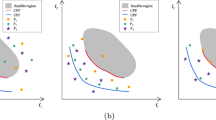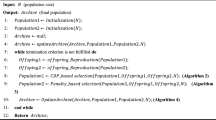Abstract
Constrained multi-objective problems (CMOPs) require balancing convergence, diversity, and feasibility of solutions. Unfortunately, the existing constrained multi-objective optimization algorithms (CMOEAs) exhibit poor performance when solving the CMOPs with complex feasible regions. To solve this shortcoming, this work proposes an improved algorithm named the CMOEA-TCP, which maintains two populations cooperating to push the solutions to approximate the constrained Pareto front. Specifically, one population is obtained by the Pareto-based method and aims to strengthen the algorithm’s convergence ability. Meanwhile, another population is maintained by decomposition-based method and devoted to improving its diversity. The two populations work cooperatively during the entire evolution process with the constraint-handling technique. The performance of the CMOEA- TCP is verified on three benchmark suites with 34 problems. The experimental results demonstrate that the CMOEA-TCP can achieve performance comparable to or better than the other six state-of-the-art CMOEAs on the majority of considered problems.







Similar content being viewed by others
References
Nguyen S, Thiruvady D (2020) Evolving large reusable multi-pass heuristics for resource constrained job scheduling. In: 2020 IEEE Congress on Evolutionary Computation (CEC) 1–8
Yang D, Zhou X, Yang Z, Jiang Q, Feng W (2020) Multi-objective optimization model for flexible job shop scheduling problem considering transportation constraints: a comparative study. In:2020 IEEE Congress on Evolutionary Computation (CEC) 1–8
Li J, Wang Y, Yang S, Cai Z (2016) A comparative study of constraint-handling techniques in evolutionary constrained multiobjective optimization. In: 2016 IEEE Congress on Evolutionary Computation (CEC) 4175–4182
Wang C, Xu R (2016) An angle based evolutionary algorithm with infeasibility information for constrained many-objective optimization. Appl Soft Comput 86:105911
Liu Z, Wang Y (2019) Handling constrained multiobjective optimization problems with constraints in both the decision and objective spaces. IEEE Trans Evolut Comput 23(5):870–884
Zitzler E, Laumanns M, Thiele L (2001) SPEA2: improving the strength Pareto evolutionary algorithm for multiobjective optimization. In: Paper presented at the evolutionary methods for design, optimization and control with applications to industrial problems. Proceedings of the EUROGEN’2001, Athens, Greece, 19–21 September
Wang H, Sun C, Zhang G, Fieldsend JE, Jin Y (2021) Non-dominated sorting on performance indicators for evolutionary many-objective optimization. Inf Sci 551:23–38
Zhang Q, Hui L (2007) MOEA/D: a multiobjective evolutionary algorithm based on decomposition. IEEE Trans Evolut Comput 11(6):712–731
Zou J, He Y, Zheng J, Gong D, Yang Q, Fu L et al (2021) Hierarchical preference algorithm based on decomposition multiobjective optimization. Swarm Evolut Comput 60:100771
Chen J, Ding J, Tan KC, Chen Q (2021) A decomposition-based evolutionary algorithm for scalable multi/many-objective optimization. Memet Comput 13(3):413–432
Falcón-Cardona JG, Coello CAC (2020) Indicator-based multi-objective evolutionary algorithms: a comprehensive survey. ACM Comput Surv 53(2):1–35
Shang K, Ishibuchi H, He L, Pang LM (2021) A survey on the hypervolume indicator in evolutionary multi-objective optimization. IEEE Trans Evolut Comput 25(1):1–20. https://doi.org/10.1109/TEVC.2020.3013290
Liang Z, Luo T, Hu K, Ma X, Zhu Z (2021) An indicator-based many-objective evolutionary algorithm with boundary protection. IEEE Trans Cybern 51(9):4553–4566. https://doi.org/10.1109/TCYB.2019.2960302
Li L, Wang X (2021) An adaptive multiobjective evolutionary algorithm based on grid subspaces. Memet Comput 13(2):249–269
Cui Z, Zhang M, Wang H, Cai X, Zhang W, Chen J (2020) Hybrid many-objective cuckoo search algorithm with Lévy and exponential distributions. Memet Comput 12(3):251–265
Yu X, Yu X, Lu Y, Yen GG, Cai M (2018) Differential evolution mutation operators for constrained multi-objective optimization. Appl Soft Comput 67:452–466
Yang Y, Liu J, Tan S (2020) A constrained multi-objective evolutionary algorithm based on decomposition and dynamic constraint-handling mechanism. Appl Soft Comput 89:106104
Deb K, Pratap A, Agarwal S, Meyarivan T (2002) A fast and elitist multiobjective genetic algorithm: NSGA-II. IEEE Trans Evolut Comput 6(2):182–197
Liu Z, Wang Y, Wang B (2021) Indicator-based constrained multiobjective evolutionary algorithms. IEEE Trans Syst Man Cybern Syst 51(9):5414–5426. https://doi.org/10.1109/TSMC.2019.2954491
Jain H, Deb K (2014) An evolutionary many-objective optimization algorithm using reference-point based nondominated sorting approach, Part II: handling constraints and extending to an adaptive approach. IEEE Trans Evol Comput 18(4):602–622
Wang BC, Li HX, Zhang Q, Wang Y (2021) Decomposition-based multiobjective optimization for constrained evolutionary optimization. IEEE Trans Syst Man Cybern Syst 51(1):574–587. https://doi.org/10.1109/TSMC.2018.2876335
Ma Z, Wang Y, Song W (2021) A new fitness function with two rankings for evolutionary constrained multiobjective optimization. IEEE Trans Syst Man Cybern Syst 51(8):5005–5016. https://doi.org/10.1109/TSMC.2019.2943973
Fan Z, Li W, Cai X, Hu K, Lin H, Li H (2016) Angle-based constrained dominance principle in MOEA/D for constrained multi-objective optimization problems. In: 2016 IEEE Congress on Evolutionary Computation (CEC) 460–467
Fan Z, Fang Y, Li W, Cai X, Wei C, Goodman E (2019) MOEA/D with angle-based constrained dominance principle for constrained multi-objective optimization problems. Appl Soft Comput 74:621–633
He C, Cheng R, Tian Y, Zhang X, Tan KC, Jin Y (2021) Paired offspring generation for constrained large-scale multiobjective optimization. IEEE Trans Evolut Comput 25(3):448–462
Li L, He C, Xu W, Pan L (2021) Pioneer selection for evolutionary multiobjective optimization with discontinuous feasible region. Swarm Evolut Comput 65:100932
Yu K, Liang J, Qu B, Yue C (2021) Purpose-directed two-phase multiobjective differential evolution for constrained multiobjective optimization. Swarm Evolut Comput 60:100799
Fan Z, Wang Z, Li W, Yuan Y, You Y, Yang Z et al (2020) Push and pull search embedded in an M2M framework for solving constrained multi-objective optimization problems. Swarm Evolut Comput 54:100651
Li K, Chen R, Fu G, Yao X (2019) Two-archive evolutionary algorithm for constrained multiobjective optimization. IEEE Trans Evol Comput 23(2):303–315
Fan Z, Li W, Cai X, Li H, Wei C, Zhang Q et al (2019) Push and pull search for solving constrained multi-objective optimization problems. Swarm Evol Comput 44:665–679
Wang J, Liang G, Zhang J (2019) cooperative differential evolution framework for constrained multiobjective optimization. IEEE Trans Cybern 49(6):2060–2072
Ma H, Wei H, Tian Y, Cheng R, Zhang X (2021) A multi-stage evolutionary algorithm for multi-objective optimization with complex constraints. Inf Sci 560:68–91
Tian Y, Zhang Y, Su Y, Zhang X, Tan K C, Jin Y (2021) Balancing objective optimization and constraint satisfaction in constrained evolutionary multiobjective optimization. IEEE Trans Cybern 1–14
Yang M, Zhou A, Li C, Guan J, Yan X (2020) CCFR2: a more efficient cooperative co-evolutionary framework for large-scale global optimization. Inf Sci 512:64–79
Wang J, Cen B, Gao S, Zhang Z, Zhou Y (2020) Cooperative evolutionary framework with focused search for many-objective optimization. IEEE Trans Emerg Top Comput Intell 4(3):398–412
Ma Z, Wang Y (2019) Evolutionary constrained multiobjective optimization: test suite construction and performance comparisons. IEEE Trans Evolut Comput 23(6):972–986
Zhang Q, Zhou A, Zhao S, Suganthan P, Liu W, Tiwari S (2008) Multiobjective optimization test instances for the CEC 2009 special session and competition
Fan Z, Ruan J, Li W, You Y, Cai X, Xu Z, et al. (2019) A learning guided parameter setting for constrained multi-objective optimization. In: 2019 1st International Conference on Industrial Artificial Intelligence (IAI) 1–6
Zhou J, Zou J, Zheng J, Yang S, Gong D, Pei T (2021) An infeasible solutions diversity maintenance epsilon constraint handling method for evolutionary constrained multiobjective optimization. Soft Comput 25(13):8051–8062
Su Z, Zhang G, Yue F, Zhan D, Li M, Li B et al (2021) Enhanced constraint handling for reliability-constrained multiobjective testing resource allocation. IEEE Trans Evolut Comput 25(3):537–551
Gurrola-Ramos J, Hernàndez-Aguirre A, Dalmau-Cedeño O (2020) COLSHADE for real-world single-objective constrained optimization Problems. In: 2020 IEEE Congress on Evolutionary Computation (CEC) 1–8
Ma H, Fei M, Jiang Z, Li L, Zhou H, Crookes D (2020) A multipopulation-based multiobjective evolutionary algorithm. IEEE Trans Cybern 50(2):689–702
Fu Y, Wang H, Huang M, Wang J (2019) A decomposition based multiobjective genetic algorithm with adaptive multipopulation strategy for flowshop scheduling problem. Nat Comput 18(4):757–768
Wang J, Li Y, Zhang Q, Zhang Z, Gao S (2021) Cooperative multiobjective evolutionary algorithm with propulsive population for constrained multiobjective optimization. IEEE Trans Syst Man Cybern Syst 1–16
Ming M, Trivedi A, Wang R, Srinivasan D, Zhang T (2021) A dual-population-based evolutionary algorithm for constrained multi-objective optimization. IEEE Trans Evolut Comput 25(4):739–753. https://doi.org/10.1109/TEVC.2021.3066301
Li M, Yang S, Liu X (2016) Pareto or non-pareto: bi-criterion evolution in multiobjective optimization. IEEE Trans Evolut Comput 20(5):645–665
Das I, Dennis JE (1996) Normal-boundary intersection: a new method for generating the pareto surface in nonlinear multicriteria optimization problems. SIAM J Optim 8(3):631–657
Zhu Q, Zhang Q, Lin Q (2020) A constrained multiobjective evolutionary algorithm with detect-and-escape strategy. IEEE Trans Evolut Comput 24(5):938–947
Deb K, Thiele L, Laumanns M, Zitzler E (2005) Scalable test problems for evolutionary multi-objective optimization. In: Abraham A, Jain L, Goldberg R (eds) Evolutionary multiobjective optimization: theoretical advances and applications. Springer, London, pp 105–145
Bosman PAN, Thierens D (2003) The balance between proximity and diversity in multiobjective evolutionary algorithms. IEEE Trans Evol Comput 7(2):174–188
Zitzler E, Thiele L (1999) Multiobjective evolutionary algorithms: a comparative case study and the strength Pareto approach
Tian Y, Cheng R, Zhang X, Jin Y (2017) PlatEMO: a matlab platform for evolutionary multi-objective optimization [Educational Forum]. IEEE Comput Intell Mag 12(4):73–87
Acknowledgements
This work was financially supported by the National Key Research and Development Plan under Grant No. 2020YFB1713600 and the National Natural Science Foundation of China under Grant No. 62063021; it was also supported by the Lanzhou Science Bureau project (2018-rc-98), Public Welfare Project of Zhejiang Natural Science Foundation (LGJ19E050001), and the Project of Zhejiang Natural Science Foundation (LQ20F020011).
Author information
Authors and Affiliations
Corresponding author
Additional information
Publisher's Note
Springer Nature remains neutral with regard to jurisdictional claims in published maps and institutional affiliations.
Rights and permissions
About this article
Cite this article
Zhang, J., Cao, J., Zhao, F. et al. A constrained multi-objective optimization algorithm with two cooperative populations. Memetic Comp. 14, 95–113 (2022). https://doi.org/10.1007/s12293-022-00360-1
Received:
Accepted:
Published:
Issue Date:
DOI: https://doi.org/10.1007/s12293-022-00360-1




